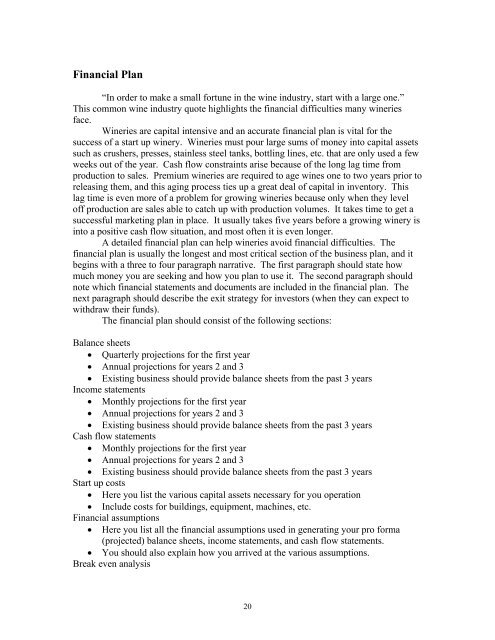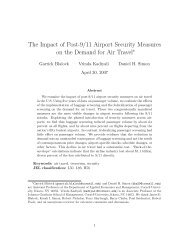Writing a Business Plan: A Guide for Small Premium Wineries
Writing a Business Plan: A Guide for Small Premium Wineries
Writing a Business Plan: A Guide for Small Premium Wineries
You also want an ePaper? Increase the reach of your titles
YUMPU automatically turns print PDFs into web optimized ePapers that Google loves.
Financial <strong>Plan</strong><br />
“In order to make a small <strong>for</strong>tune in the wine industry, start with a large one.”<br />
This common wine industry quote highlights the financial difficulties many wineries<br />
face.<br />
<strong>Wineries</strong> are capital intensive and an accurate financial plan is vital <strong>for</strong> the<br />
success of a start up winery. <strong>Wineries</strong> must pour large sums of money into capital assets<br />
such as crushers, presses, stainless steel tanks, bottling lines, etc. that are only used a few<br />
weeks out of the year. Cash flow constraints arise because of the long lag time from<br />
production to sales. <strong>Premium</strong> wineries are required to age wines one to two years prior to<br />
releasing them, and this aging process ties up a great deal of capital in inventory. This<br />
lag time is even more of a problem <strong>for</strong> growing wineries because only when they level<br />
off production are sales able to catch up with production volumes. It takes time to get a<br />
successful marketing plan in place. It usually takes five years be<strong>for</strong>e a growing winery is<br />
into a positive cash flow situation, and most often it is even longer.<br />
A detailed financial plan can help wineries avoid financial difficulties. The<br />
financial plan is usually the longest and most critical section of the business plan, and it<br />
begins with a three to four paragraph narrative. The first paragraph should state how<br />
much money you are seeking and how you plan to use it. The second paragraph should<br />
note which financial statements and documents are included in the financial plan. The<br />
next paragraph should describe the exit strategy <strong>for</strong> investors (when they can expect to<br />
withdraw their funds).<br />
The financial plan should consist of the following sections:<br />
Balance sheets<br />
• Quarterly projections <strong>for</strong> the first year<br />
• Annual projections <strong>for</strong> years 2 and 3<br />
• Existing business should provide balance sheets from the past 3 years<br />
Income statements<br />
• Monthly projections <strong>for</strong> the first year<br />
• Annual projections <strong>for</strong> years 2 and 3<br />
• Existing business should provide balance sheets from the past 3 years<br />
Cash flow statements<br />
• Monthly projections <strong>for</strong> the first year<br />
• Annual projections <strong>for</strong> years 2 and 3<br />
• Existing business should provide balance sheets from the past 3 years<br />
Start up costs<br />
• Here you list the various capital assets necessary <strong>for</strong> you operation<br />
• Include costs <strong>for</strong> buildings, equipment, machines, etc.<br />
Financial assumptions<br />
• Here you list all the financial assumptions used in generating your pro <strong>for</strong>ma<br />
(projected) balance sheets, income statements, and cash flow statements.<br />
• You should also explain how you arrived at the various assumptions.<br />
Break even analysis<br />
20



